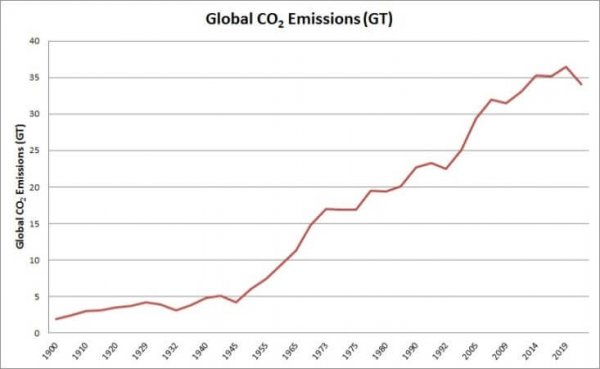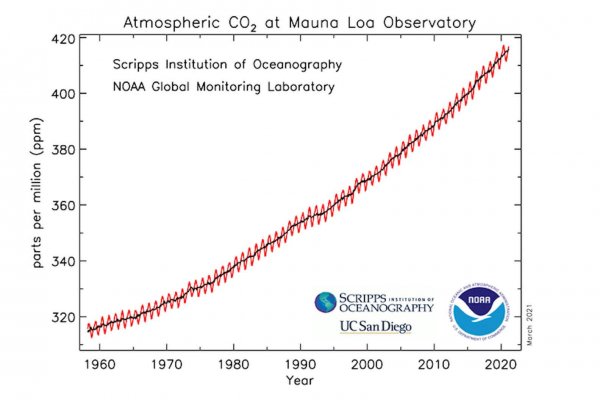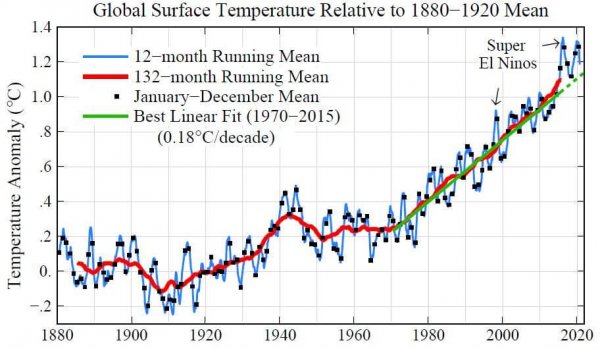
Le rôle essentiel des climatologues dans le plan de lutte contre les changements climatiques du Canada
– Par G.S. Strong et Garth Mihalcheon –
Le plan de lutte contre les changements climatiques du Canada, présenté dans le projet de loi C-12, se révèle inadéquat au vu de la crise climatique mondiale à laquelle nous sommes confrontés. Nous sommes d’avis que les scientifiques canadiens devraient jouer un rôle plus direct en convaincant le gouvernement fédéral de renforcer ce plan. Depuis les pourparlers sur le climat tenus à Paris en 2015, le Groupe d’experts intergouvernemental sur l’évolution du climat (GIEC) a demandé avec instance aux pays d’élaborer des plans plus ambitieux pour lutter contre les changements climatiques afin de maintenir les hausses de températures mondiales en deçà de 1,5°C. Ces plans et la cible du GIEC sont voués à l’échec étant donné que la plupart des pays ont adopté la formule « seuil de zéro émission d’ici 2050 », une formule promue par l’industrie des combustibles fossiles, qui devrait suffire à elle seule à éveiller les soupçons. On peut espérer bien peu de progrès jusqu’à ce que la climatologie critique officiellement les lacunes inhérentes des plans « zéro émission ».
Les climatologues participent rarement aux discussions publiques sur les solutions pour lutter contre les changements climatiques, mais cette tradition pourrait ne plus être valide à la lumière de cette menace inédite pour l’humanité, qui représente ce que Klein (2020) a appelé le ‘nouveau dénégationnisme climatique’. Nous proposons une façon de renforcer les voix des climatologues en exploitant les réseaux professionnels multidisciplinaires, et en aidant à accélérer les incitatifs du gouvernement à agir pour le climat tout en protégeant les scientifiques contre les représailles politiques.
The Essential Role of Climate Scientists in Canada’s Climate Plan
Introduction
Covid-19, political tensions and the U.S. presidential election and its aftermath have dominated news and social media coverage for more than a year. Meanwhile, the climate crisis has not disappeared, and recent climate research suggests that earlier climate predictions and IPCC reports have been too conservative. The IPCC insists countries must develop more ambitious climate plans to keep global temperature increases below 1.5°C. These plans and the IPCC target seem doomed to failure because they emphasize the use of various unproven sequestration processes to both reduce emissions and extract carbon dioxide from the atmosphere, with less emphasis on the more immediate need for reductions in industrial emissions.
Climate scientists rarely engage in public discussions on climate change solutions. That tradition of avoidance is no longer valid in the face of this greatest threat ever to humanity, for it represents what Klein (2020) calls the ‘new climate denialism’. Given the magnitude of the crisis, Canada’s climate plan presented under Bill C-12 is insufficient to “do our fair share” to restrain the climate juggernaut. We believe Canadian scientists are equipped to play a more direct role in convincing the federal government to strengthen this plan. Other groups such as Cologna et al. (2021) are also calling on scientists to play a more active role in policy advocacy. We suggest a way of strengthening their voices through interdisciplinary networks.
Trends in Global Emissions, Atmospheric CO2, and Global Temperatures
Figures 1-3 summarize the certainties around global warming, showing (1) global carbon emissions for 1900-2020, (2) atmospheric concentrations of CO2 for 1957-2020, and (3) resulting trends in global mean temperatures from 1880 to 2020. These have common features in that all are increasing at accelerated rates since at least 1970, the atmosphere being both mixer and equalizer.

The fossil fuel industry and governments have pointed out that because of industry shut-downs because of Covid in 2020, emissions dropped 8% overall from 2019. However, any emission reductions were temporary and did nothing to change the rate of rise in atmospheric CO2 (Fig. 2) or mean global temperature anomalies (Fig. 3).
If global carbon emissions continue unabated through 2050, as allowed by Canadian and other national plans, then atmospheric CO2 will continue to rise at an ever-increasing exponential rate (as in Fig. 2), and global mean temperatures must also continue to rise faster (as in Fig. 3). The last seven years have been the seven warmest years on record, and all exceed the best linear fit of mean global temperatures (green line in Fig. 3). Those years represent too short a time to declare an increasing trend, but it is not insignificant.
Tipping Points

Tipping points in the climate have been postulated since the 1990s. This refers to a threshold, or point of no return in the climate system, that once passed, can no longer be reversed. We refer readers to Hansen et al. (2012), Lenton et al. (2019), Randers and Goluke (2020), and Duffy et al. (2021) for most recent work on tipping points. While a tipping point does not guarantee immediate, drastic consequences, it does mean impacts become unavoidable and dramatic. A tipping point can occur when several ‘positive feedbacks’ coincide at a certain level of warming, causing the climate to lurch to a higher mean temperature over a short period (a decade or two) as nature attempts to stabilize it. Positive feedbacks include: melting of summer Arctic sea and land ice cover, reducing the albedo; increases in atmospheric methane from melting northern permafrost and southern fracking for oil and gas; drying and burning of the Amazon rainforest, changing it from being a carbon sink to a major carbon source; and global warming itself, which allows for more water vapour, the strongest climate warmer. When such feedbacks coincide, you have a recipe for an apocalypse – accelerated global warming, massive species extinctions, and social disruptions from which civilization might not recover.

Two decades ago, the IPCC Third Assessment Report acknowledged that a tipping point could occur if global warming exceeded 5 °C above pre-industrial levels. However, Steffen et al. (2018) suggested this could occur with even less than 2 °C of warming, after which IPCC warnings intensified. Global warming has reached 1.4 °C (1910 to 2020 in Fig. 3), while the last seven years of warming might even be an early hint of an approaching tipping point.
Social tipping points can also transform entire societies (Gladwell, 2000). History is replete with examples from the profound (such as the assassination of Archduke Franz Ferdinand, leading to World War I) to the absurd (the latest viral conspiracy theory). Unfortunately, the well-funded information war against climate action has been ‘tipping’ in favour of fossil fuel companies for years. Climate scientists can help tip public opinion back toward necessary climate action, but they need to leave their comfort zone to do so and address both government and the public.
‘Net-Zero’ Emissions
News media and the public appear mollified by aspirational pledges of future emission reductions. Prominent among these pledges is the new catchphrase, “net-zero emissions by 2050”. The problem with ‘net-zero’ is that it allows countries to bank on unproven or non-existent ‘negative emissions technologies’ (NETs) to absorb current carbon emissions in the future while allowing fossil fuel production to continue. For example, the US climate envoy, John Kerry, recently admitted (here) that 50% of the carbon reductions needed to get to net-zero will come from technologies that have not yet been invented. That approach is unacceptable, for it encourages complacency among media and the public, when in reality we may be headed towards a runaway climate disaster.
Agreements signed following the 2015 Paris climate talks (COP-21) promising to reduce emissions by at least 35% by 2030 have not been honoured, with emissions growing each year. The United Nations Secretary-General, Antonio Guterres stated in February 2021 that “if all the national pledges submitted so far were fulfilled, global emissions would be reduced by only 1% by 2030, compared with 2010 levels.” He added that 2021 is the make-or-break year to confront the global climate emergency.
Adding to the confusion, ‘Project Drawdown’ (Hawken, 2017) is an initiative that relies on NETs, listing some 80 projects that result in carbon sequestration. These include planting billions of trees, improving land use and agriculture, transitioning transportation and industry from fossil fuels to renewable energy, point-source carbon capture and storage (CCS), and direct air capture (DAC) of carbon dioxide (CO2) from the atmosphere. One drawback of Drawdown is that it doesn’t account for the timelines these projects require. For example, it can take up to 50-100 years for a tree to reach maturity and maximum carbon intake, while fossil fuel vehicles will be in major use for at least another decade. What is worse is that these initiatives redirect responsibility for emissions reductions from fossil fuel companies to citizens: “Blame the victim” is another public relations staple of Big Oil. The major weakness of net-zero rationale is a reliance on technologies that are unproven at meaningful scales. Meanwhile, we have just eight years to make good on our global pledge to reduce carbon emissions by at least 40% by 2030.
Canada’s New Climate Plan
We commend the inclusion of the carbon tax in Canada’s climate plan that increases to $170/tonne by 2030, about $0.38 per litre of gasoline at the pump. The plan also includes spending $15 billion on “green initiatives,” but it gives few details on how they would spend this money. Beyond these aspirations, the plan lacks a roadmap for getting to 2030, let alone 2050 and beyond. Other national climate plans also speak of the necessity for emission reductions but omit the project plan for how to get there.
The Canadian plan, presented as Bill C-12 in parliament, provides no details or demands on industry to reduce emissions. It then leaps into a promise to “reduce Canada’s carbon emissions by 40%–45% by 2030”, while immediately following, one notices “from federal facilities and conventional fleets,” a deception never mentioned in news releases. The baseline year for Canada is 2005, when emissions peaked at 730 MT. One can interpret ‘net-zero’ then to mean keeping emissions at or below 730 MT each subsequent year. Canadian media and the public have applauded the plan, and even environmental watchdogs like the David Suzuki Foundation, Greenpeace, and Pembina Institute have given it tacit support as ‘a good start’. However, people are slow to catch on that ‘net-zero’ could mean that carbon emissions will continue unabated through 2050!
It should not surprise us that the fossil fuel industry hasn’t complained about ‘net-zero’ plans. According to Carter & Dordi (2021), “Big Oil” helped to persuade governments to accept the concept. Carter & Dordi refer to the plan as a “one-eye-shut” climate policy, for it encourages oil/gas exploration and production through ongoing subsidies and completion of the Trans-Mountain pipeline. They conclude Canada is not taking a leadership role and is out of step with the imperative to phase out global fossil fuel production.
‘Net-zero’ is emblematic of a fundamental flaw in market-based climate solutions, where they favour short-term profits over long-term risk reduction. Understanding the foregoing, we should question why Canada’s media and public accept Canada’s weak climate plan. One obvious remedy to this problem is that we need our climate science establishment to get off the sidelines and express their concern in the strongest language. We will fail unless scientists push national governments to enact the binding climate legislation only they can enforce. As Greta Thunberg insists, we must pressure them to “listen to the science.” But first, scientists must speak loudly enough to be heard over the protests of vested interests.
Networking with Other Disciplines
It is stressful for climate scientists to wade into the political minefield of climate change, and this is especially true for government scientists who might criticize their employers. However, the public is confused over where to turn for credible climate change information. Schmidt (2015) and Cologna et al. (2021) show that a large majority of the public supports the advocacy of climate researchers. An informed democracy is more likely to make good decisions than one where ignorance and partisanship dominate. Moreover, Kotcher et al. (2017) showed that climate scientists who advocate for better policies can do so without harming their credibility or the credibility of their scientific community.We have the advantage to form networks that multiply and extend the impact of individual actions throughout society. Milkoreit et al. (2018) show that with human networks “a small quantitative change can trigger a non-linear change in the social-ecological system, driven by positive feedback mechanisms that often lead to a different state of the social system.” The good news is that novel interdisciplinary networks of scientists and professionals have been able to amplify the voices of change while providing cover for the political consequences of speaking up. Rather than speaking in isolation, climate scientists can network with other professional disciplines contributing to public discussion. Below, we give two examples of effective professional networks in the health care sector and international aid organizations.
For example, one of us (Mihalcheon) has been active in the development and implementation of Practitioner Health Networks, including BC’s ongoing Primary Care Network (PCN), to enhance access to and coordinate patient care among ‘siloed’ health disciplines, departments and services. Evidence describes improved patient care and financial benefits (e.g., Alberta Health Services 2016). But perhaps the greatest benefits have accrued to family physicians themselves, who have worked in isolation and felt disempowered in advocating for systemic change. Family doctors, like research scientists, can face serious repercussions for not “staying in their lane.” The power of PCNs is to open up interdisciplinary channels of communication and best practices throughout different health care delivery systems.
One of us (Strong) has volunteered for many years in the international aid program of the Anglican Church. He found that speaking about climate change impacts on international aid generated little response or even negative response among other aid workers. However, once he showed that most (>90%) of our emergency aid (other than for earthquakes) applies to the same regions of the subtropics most severely affected by climate impacts like desertification, drought-causing famines and coastal tropical storms, aid workers immediately recognized those critical connections. This heightened awareness led to a climate group being formed within the organization. Most aid agencies operating in the subtropics have increased their attention to climate change via network connections, where aid work provides additional sources of data on climate impacts.
Besides epidemiologists and international aid experts, there are many other scientific disciplines that could lend their support to climate scientists. The Canadian Meteorological and Oceanographic Society (CMOS) could collaborate with other professional networks in broadcasting updated statements on climate change initiatives and impacts annually, strengthening its brand and social relevance.
Conclusions
The current Canadian climate plan represented by Bill C-12[1] is weak and deceptive, lulling the public and media into the false hope that we are well on the way to defeating climate change. While we require climate legislation only national governments can implement, the factual basis for this legislation must come from climate scientists, not self-interested industry-government alliances or Facebook conspiracy theories.
Policy analyst Klein (2020) makes a strong case for a ‘wartime’ mindset and political policy agenda in order to tackle the climate emergency. Mann (2021) suggests that climate change is now a ‘new climate war,’ where we must overcome “greenwashing” by the fossil fuel industry and the conspiratorial narratives of denialism. We urge climate scientists to step outside their comfort zones while remaining true to humanity’s greatest ethical imperative: being the best possible ancestors for trillions of unborn people.
Interdisciplinary climate advocacy networks can connect climate scientists with diverse perspectives and political connections, and even suggest new directions for research. We urge climate scientists to add their voices to those of other scientists, fellow citizens, our children and trillions of unborn creatures. Greta Thunberg said, “… hope is telling it like it is.” That is what scientists do best. In this battle for a habitable Earth, society needs more than wishful thinking and a political spin. Our climate peril demands the rational hope only science can deliver. We must raise our collective voices to counter ‘net-zero’ thinking with legislated, measurable and enforceable emission reductions in this decade, rather than waiting for some unproven technology fix. As Bill McKibben, founder of 350.org has said, “winning slowly on climate change is just another way of losing.” This is a war humanity must not lose.
[1] Just as we submit this article, we learn that Bill C-12 passed second reading in the House of Commons. It’s now headed to the Environment Committee, where MPs could either weaken or strengthen the legislation. This makes it even more important for climate scientists to act in support for strengthening the legislation.
Garth Mihalcheon has a BSc in Psychology from the University of Alberta and an MBA in Marketing from the University of Calgary. He has worked as a musician, emergency room crisis counsellor, health care manager, health consultant and project manager in developing the first commercial internet services in Canada. Garth still refuses to stay in his own lane.
Geoff Strong is an atmospheric/climate scientist by profession (Ph.D, University of Alberta, 1986), who retired from Environment Canada in 1998. He is a Fellow of and former national President of the Canadian Meteorological & Oceanographic Society (CMOS, 2006-07), and has received several awards from that society.
He devotes time to providing public education on climate change through seminars and media articles. More recently, he expanded his writings to include fictional novels on climate change, which also provide accurate information on the science without detracting from an interesting story. Geoff’s published novels include “Convenient Mistruths” (2017) and “Inconvenient Pipeline” (2020). He occasionally teaches environmental courses at several universities and participates in several environmental organizations on the island.